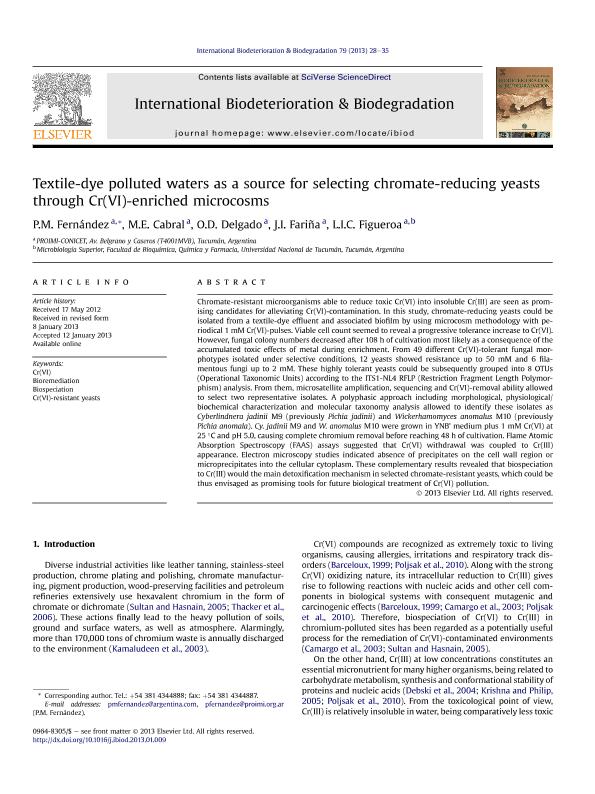Artículo
Textile-dye polluted waters as a source for selecting chromate-reducing yeasts through Cr(VI)-enriched microcosms
Fernandez, Pablo Marcelo ; Cabral, Maria Eugenia
; Cabral, Maria Eugenia ; Delgado, Osvaldo Daniel
; Delgado, Osvaldo Daniel ; Fariña, Julia Inés
; Fariña, Julia Inés ; Castellanos de Figueroa, Lucia Ines
; Castellanos de Figueroa, Lucia Ines
 ; Cabral, Maria Eugenia
; Cabral, Maria Eugenia ; Delgado, Osvaldo Daniel
; Delgado, Osvaldo Daniel ; Fariña, Julia Inés
; Fariña, Julia Inés ; Castellanos de Figueroa, Lucia Ines
; Castellanos de Figueroa, Lucia Ines
Fecha de publicación:
01/2013
Editorial:
Elsevier
Revista:
International Biodeterioration and Biodegradation
ISSN:
0964-8305
Idioma:
Inglés
Tipo de recurso:
Artículo publicado
Clasificación temática:
Resumen
Chromate-resistant microorganisms able to reduce toxic Cr(VI) into insoluble Cr(III) are seen as prom- ising candidates for alleviating Cr(VI)-contamination. In this study, chromate-reducing yeasts could be isolated from a textile-dye effluent and associated biofilm by using microcosm methodology with pe- riodical 1 mM Cr(VI)-pulses. Viable cell count seemed to reveal a progressive tolerance increase to Cr(VI). However, fungal colony numbers decreased after 108 h of cultivation most likely as a consequence of the accumulated toxic effects of metal during enrichment. From 49 different Cr(VI)-tolerant fungal mor- photypes isolated under selective conditions, 12 yeasts showed resistance up to 50 mM and 6 fila- mentous fungi up to 2 mM. These highly tolerant yeasts could be subsequently grouped into 8 OTUs (Operational Taxonomic Units) according to the ITS1-NL4 RFLP (Restriction Fragment Length Polymor- phism) analysis. From them, microsatellite amplification, sequencing and Cr(VI)-removal ability allowed to select two representative isolates. A polyphasic approach including morphological, physiological/ biochemical characterization and molecular taxonomy analysis allowed to identify these isolates as Cyberlindnera jadinii M9 (previously Pichia jadinii) and Wickerhamomyces anomalus M10 (previously Pichia anomala). Cy. jadinii M9 and W. anomalus M10 were grown in YNB’ medium plus 1 mM Cr(VI) at 25 C and pH 5.0, causing complete chromium removal before reaching 48 h of cultivation. Flame Atomic Absorption Spectroscopy (FAAS) assays suggested that Cr(VI) withdrawal was coupled to Cr(III) appearance. Electron microscopy studies indicated absence of precipitates on the cell wall region or microprecipitates into the cellular cytoplasm. These complementary results revealed that biospeciation to Cr(III) would the main detoxification mechanism in selected chromate-resistant yeasts, which could be thus envisaged as promising tools for future biological treatment of Cr(VI) pollution.
Palabras clave:
BIOREMEDIATION
,
BIOSPECIATION
,
CR(VI)
,
CR(VI)-RESISTANT YEASTS
Archivos asociados
Licencia
Identificadores
Colecciones
Articulos(CCT - NOA SUR)
Articulos de CTRO.CIENTIFICO TECNOL.CONICET - NOA SUR
Articulos de CTRO.CIENTIFICO TECNOL.CONICET - NOA SUR
Articulos(PROIMI)
Articulos de PLANTA PILOTO DE PROC.IND.MICROBIOLOGICOS (I)
Articulos de PLANTA PILOTO DE PROC.IND.MICROBIOLOGICOS (I)
Citación
Fernandez, Pablo Marcelo; Cabral, Maria Eugenia; Delgado, Osvaldo Daniel; Fariña, Julia Inés; Castellanos de Figueroa, Lucia Ines; Textile-dye polluted waters as a source for selecting chromate-reducing yeasts through Cr(VI)-enriched microcosms; Elsevier; International Biodeterioration and Biodegradation; 79; 1-2013; 28-35
Compartir
Altmétricas



